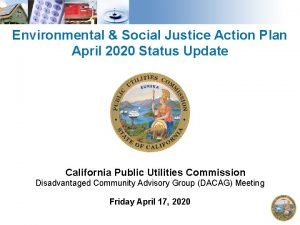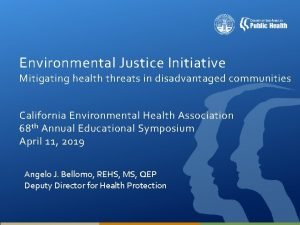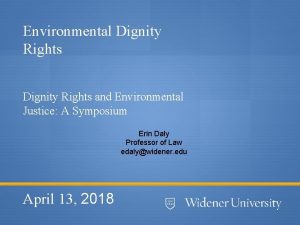Environmental Health and Environmental Justice on St Lawrence


- Slides: 2

Environmental Health and Environmental Justice on St. Lawrence Island, Alaska J. Chiarenzelli (SUNY Potsdam) and Catherine Shrady (St. Lawrence University) acknowledge the work and generosity of the following people and organizations: David Carpenter, Tony De. Caprio, Pamela Miller, Ron Scrudato, Alaska Community Action on Toxics, SUNY Albany, National Institute of Environmental Health Sciences Environmental Justice program, and the people of St. Lawrence Island for allowing us to share their story. PCBs in Blood Serum Images summarizing environmental health issues at Northeast Cape. Counter clockwise from upper left: • Satellite photo of St. Lawrence Island, Alaska demonstrating military significance during the cold war and remote location (NASA-JPL); • PCB levels in blood serum of St. Lawrence Island residents (SUNY Albany); • Caribou antlers ensnared in copper wire demonstrating physical hazards left behind (Alaska Community Action on Toxics); • Main complex at Northeast Cape showing fuel tanks from which 220, 000 gallons of fuel was spilled (Alaska Community Action on Toxics); • Annie Alowa, deceased Yup’ik elder and tireless advocate for her community besides drum disposal site at Northeast Cape (Alaska Community Action on Toxics); . Geology and Human Health Chico Hot Springs, Montana May 12 – 16, 2004 National Science Foundation

Contaminant Dispersion and Exposure at Northeast Cape Sediment cores from the Northeast Cape Main Complex and Suqi Estuary nearly a mile away have polychlorinated biphenyl (PCB) concentrations equal to impacted and rural areas in North America. Air sampling indicates concentrations similar to those from highly impacted, industrial sites elsewhere. This supports a local, rather than long-distance, source for PCBs. Site characterization, background concentrations, and the recommended use of congener-specific PCB analyses are contentious issues. Dispersion and partitioning of contaminants from the Northeast Cape site has resulted in contamination of environmental media. Mirex, a banned pesticide and flame retardant, and PCBs increase upwards in sediment cores indicating erosion of a primary on-site source. Dust from the site and uptake from contaminated soils effect plants used for food and medicine. Preferential partitioning of the lower chlorinated congeners via volatilization and solubilization alters the chemical fingerprint of the technical mixtures (Aroclors) used. The high PCB chlorination in air and water argue against long-distance atmospheric transport of the contaminants.



